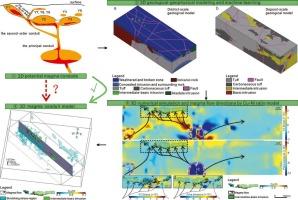Multi-scale 3D modeling by machine learning and numerical simulation for potential magma conduit in the Kalatongke district, Xinjiang, China
IF 3.6
2区 地球科学
Q1 GEOLOGY
引用次数: 0
Abstract
The Kalatongke district in the Central Asian Orogenic Belt has the largest magmatic Cu–Ni sulfide deposit in Xinjiang, China. After more than 40 years of continuous multi-scale scientific research on known deposits in the district, useful results have been achieved, and large volumes of geological data, geophysical data and engineering data have been accumulated. However, there are still many hot scientific issues in the Kalatongke district, such as the location of magma conduit, magma flow feature, the relationship between carbonaceous rock and mineralization, the stress characteristics during mineralization, and the stratification characteristics of intermediate–basic rocks. We used machine learning technology and numerical simulation technology to tackle the above-mentioned scientific problems from a district- and deposit-scale mineral system perspective. The specific district-scale research steps were as follows: (1) unsupervised K-means method was used to cluster data on four petrophysical properties (density, magnetic susceptibility, resistivity and seismic wave propagation velocity) to obtain a district-scale 3D geological body model, which was applied to reveal the ore-bearing rock and its surrounding rock; (2) faults were interpreted using gravity data, magnetic data, electromagnetic data and seismic data, and a 3D regional fault model was established to show the location of potential magma conduit; and (3) a stress field model and a pore pressure model reflecting fluid characteristics were obtained by numerical simulation technology, so that the district-scale stress feature in 3D space can be integrated with magma conduit. The specific deposit-scale research steps were as follows: (1) a secondary fault model was built by 3D modeling based on geological–geophysical data in order to indicate potential secondary magma conduit; and (2) based on 239 borehole data, a deposit-scale rock model was classified using neural network technology to show the spatial distribution feature of carbonaceous rock and orebody; and (3) the ratio of Cu to Ni geochemical data was used to obtain a Cu–Ni ratio model, which was used to determine the direction of magma flow. Based on these studies of district-scale and deposit-scale ore-forming system, the features of tension and extrusion stress were combined with the melt–fluid flow direction deduced from the Cu–Ni ratio model, and a 3D magmatic conduit model in the Kalatongke district was built. According to this magmatic conduit model and the metallogenic geological characteristics of the area, three A-rank and three B-rank targets were delineated, which can further guide mineral exploration in the district. The research methods and techniques described in this paper are useful for investigating potential magma conduits of magmatic Cu–Ni sulfide deposits elsewhere.

新疆喀拉通克地区潜在岩浆通道的机器学习多尺度三维建模与数值模拟
中亚造山带喀拉通科地区是中国新疆最大的岩浆型铜镍硫化物矿床。经过40多年对该区已知矿床的持续多尺度科学研究,取得了有益的成果,积累了大量的地质资料、地球物理资料和工程资料。然而,克拉通克地区岩浆通道的位置、岩浆流动特征、碳质岩与成矿的关系、成矿过程中的应力特征、中基性岩的分层特征等仍是该区科学研究的热点问题。我们利用机器学习技术和数值模拟技术,从区域和矿床尺度的矿物系统角度解决了上述科学问题。具体的区域尺度研究步骤如下:(1)利用无监督K-means方法对密度、磁化率、电阻率、地震波传播速度等4种岩石物性数据进行聚类,得到区域尺度三维地质体模型,并应用该模型揭示含矿岩及其围岩;(2)利用重、磁、电磁、地震等资料对断层进行了解释,建立了三维区域断层模型,显示了潜在岩浆通道的位置;(3)通过数值模拟技术获得了反映流体特征的应力场模型和孔隙压力模型,从而将岩浆管道三维空间的区域尺度应力特征整合起来。具体的矿床尺度研究步骤如下:(1)根据地质-地球物理资料,通过三维建模建立次生断裂模型,以指示潜在的次生岩浆通道;(2)基于239口钻孔资料,利用神经网络技术对矿床尺度岩石模型进行分类,反映了碳质岩石和矿体的空间分布特征;(3)利用Cu / Ni地球化学数据得到Cu - Ni比值模型,用于确定岩浆流动方向。在区域尺度和矿床尺度成矿系统研究的基础上,结合Cu-Ni比模型推导出的熔融流体流动方向,建立了卡拉通克地区的三维岩浆通道模型。根据该岩浆通道模型和区内成矿地质特征,圈定了3个a级和3个b级靶区,可进一步指导区内的找矿工作。本文所描述的研究方法和技术,对其他地区寻找岩浆型铜镍硫化物矿床的潜在岩浆通道具有指导意义。
本文章由计算机程序翻译,如有差异,请以英文原文为准。
求助全文
约1分钟内获得全文
求助全文
来源期刊

Ore Geology Reviews
地学-地质学
CiteScore
6.50
自引率
27.30%
发文量
546
审稿时长
22.9 weeks
期刊介绍:
Ore Geology Reviews aims to familiarize all earth scientists with recent advances in a number of interconnected disciplines related to the study of, and search for, ore deposits. The reviews range from brief to longer contributions, but the journal preferentially publishes manuscripts that fill the niche between the commonly shorter journal articles and the comprehensive book coverages, and thus has a special appeal to many authors and readers.
 求助内容:
求助内容: 应助结果提醒方式:
应助结果提醒方式:


